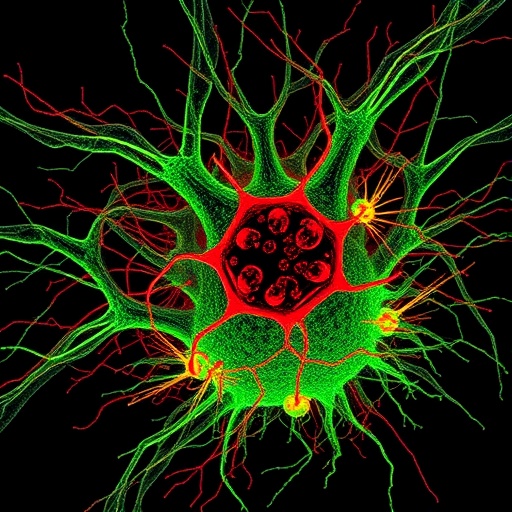Researchers at the University of Science and Technology of China (USTC) have unlocked a fundamental aspect of how our brain operates by elucidating the mechanisms of synaptic vesicle (SV) release and recycling, a process pivotal for neuronal communication. This breakthrough addresses a long-standing debate in neuroscience that has persisted for over five decades, concerning whether synaptic transmission occurs via a transient “kiss-and-run” process or an irreversible “full-collapse” fusion method. This exhaustive study, which was led by Professor Bi Guo-Qiang and his team, promises to reshape our understanding of synaptic function and its implications for brain activity.
At the heart of this research lies an innovative technique known as time-resolved cryo-electron tomography (cryo-ET). Developed specifically for this study, this method combines optogenetic stimulation—where light is used to activate neurons—with an extraordinarily fast plunge-freezing technique. This combination allows researchers to capture detailed snapshots of the intricate processes that occur during synaptic transmission at an unprecedented temporal resolution. The researchers meticulously recorded more than a thousand tomograms of cultured excitatory synapses, each frozen at various time points from 0 to 300 milliseconds after an action potential, or nerve impulse.
Upon analyzing these high-resolution images, the team identified a distinct sequence of events in the synaptic vesicle release process. Within an astonishingly brief interval of just 4 milliseconds following the initiation of an action potential, the synaptic vesicle first establishes a loose fusion with the presynaptic membrane, forming a small fusion pore—which they aptly dubbed the “kiss.” This phase is immediately followed by a unique contraction phase, in which the vesicle shrinks to about half its original surface area, a stage referred to as “shrink.” This shrinking phenomenon appears crucial, as it happens so quickly that it had eluded researchers’ ability to visualize it before this groundbreaking study.
Following the initial phases of fusion and contraction, the research team observed that by approximately 70 milliseconds, a significant majority of these small vesicles began to efficiently recycle through what they have termed the “run” pathway. This path’s efficiency stands in stark contrast to the previously assumed notion of a stringent, binary choice between full-collapse fusion and kiss-and-run. Additional observations revealed that while many vesicles successfully enter this recycling phase, a percentage of them still undergo full-collapse fusion, showcasing the complexity of this synaptic process.
What is particularly salient about this new model—the “kiss-shrink-run” mechanism—is that it manages to reconcile disparate theories that have garnered attention over the years. This fluid model captures the essence of synaptic vesicle dynamics and presents a framework that integrates both rapid recycling and irreversible fusion. As such, it offers a more nuanced understanding of the mechanisms underpinning synaptic transmission, contributing significantly to the larger discourse on how neurons communicate.
Moreover, understanding the “kiss-shrink-run” mechanism holds implications beyond basic neuroscience. This work sheds light on areas related to synaptic plasticity, which is crucial for learning and memory, as well as links to various neurological disorders. The research enhances our comprehension of how synaptic efficiency and fidelity directly influence cognitive processes, which may have profound consequences in understanding conditions characterized by synaptic dysfunction, such as Alzheimer’s disease or schizophrenia.
The technological advancements demonstrated in this study pave the way for future investigations into membrane dynamics and molecular interactions. By employing high spatiotemporal precision, researchers now have a robust framework that can be adapted to interrogate similar processes in other neuronal systems. This breakthrough signifies a leap in both the capabilities of cryo-electron tomography and our understanding of neuronal communication.
The implications of this research extend even further, challenging traditional views in neuroscience while enriching the dialogue surrounding neuronal behavior. As the research community grapples with the complexity of neural interactions, findings like those presented in this study reinforce the notion that the brain functions at a level of complexity that goes beyond simple binary models. Rather than adhering to rigid classifications, the brain seems to operate within a spectrum of processes that must be appreciated in their totality.
By articulating the exact nature of vesicle exocytosis and recycling pathways, researchers hope to elicit a new wave of inquiry that can further dissect the intricate choreography of neuronal communication. Each finding reveals not merely facts, but also the potential connections between synapse functionality and broader cognitive processes. This rich tapestry of interactions speaks to the profound nature of our neural architecture and its implications for understanding human behavior.
In conclusion, the work of Bi Guo-Qiang and his team stands as a testament to the potential of interdisciplinary research in redefining established doctrines. It beckons for deeper explorations into the unknown realms of neuronal communication and serves as a call to the next generation of neuroscientists to continue peeling back the layers of complexity that define our cognitive faculties. As they venture into these labyrinthine pathways, the promise of additional revelations regarding the dynamic nature of synaptic function looms ever larger on the horizon.
This pivotal study underscores the extraordinary capacity of modern techniques to unravel the complexities of neural function and presents a fresh lens through which to view synaptic communication in the brain. The unveiling of the “kiss-shrink-run” mechanism not only resolves longstanding debates but also ignites new inquiries into the nuances of how our brains operate, influencing everything from basic learning to complex behavioral phenomena.
As the scientific community disseminates these findings, the implications ripple outward, potentially affecting not just neuroscience but also medicine, education, and psychology. By fostering a more comprehensive understanding of synaptic processes, scientists can better prepare to address the challenges posed by neurological diseases, thus enriching human life through enhanced knowledge of brain function.
Subject of Research: Mechanisms of Synaptic Vesicle Release and Recycling
Article Title: “Kiss-shrink-run” unifies mechanisms for synaptic vesicle exocytosis and hyperfast recycling
News Publication Date: October 17, 2023
Web References: DOI link
References: Science, October 2023
Image Credits: Prof. Bi’s team
Keywords
Life sciences, Neuroscience




